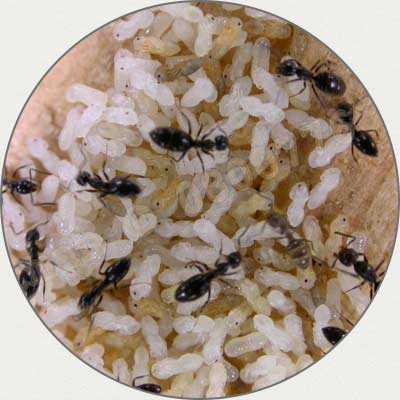The White Footed Ant
Find out more about one of the most widespread pests in the Wellington, Manawatu, and Wairarapa regions
At Antman®, we pride ourselves in being specialist for handling all pest control requirements relating to the white-footed ant in the greater Wellington, Manawatu, and Wairarapa regions. Find out more below or call us on 0800 77 66 33.
What are white footed ants?

White Footed Ant Nesting
White-footed ants’ nests can be commonly found in the greater Wellington region, inside a building’s structural cavities (roof-space, sub-floors and wall voids), where they are protected from environmental extremes. An infestation can consist of one or more satellite nests that are interconnected and may contain up to two million individuals. Ants within the same colony may be found nesting at several locations around the same structure.
There are many queens in an ant colony, which may have numerous ‘satellite’ nests branching out from the main one. The ant nests don’t have any structure, they just occupy surfaces inside cavities. The white-footed ant has not been reported to cause any direct structural damage the way carpenter ants do in other parts of the world. However, they are often found nesting in warm places, such as electrical power points or switch boxes, which can result in them short-circuiting.
White Footed Ant Reproduction
New colonies of white-footed ants are formed by swarming and budding. Swarming happens usually around the start of winter. Winged adult males and females are produced by the colony. They fly away en masse to start new colonies elsewhere. Budding is when wingless reproductive ants, along with a large number of worker ants (who carry larvae and pupae), crawl away en masse to form a new colony a short distance from the parent colony.
White Footed Ant Diet
Parasites on outdoor plants, such as aphids and scale insects, secrete honeydew. Honeydew is a popular food source for the white-footed ant. The White-footed Ants protect the parasites from predators, which results in increased damage to your plants. The ant also gets its sugar fix from the nectar of some trees and shrubs.
Vegetation favoured by the white-footed ant in the greater Wellington region is the Virginia Creeper, the Norfolk pine, and the camellia, citrus, Manuka and Pohutukawa tree. Occasionally you may find the ants feeding on dead insects, pet food or household food scraps, in these situations they are seeking protein.
Only one part of the colony forages for food and unlike most other species, they don’t regurgitate the food they have eaten to the non-foraging ants. Instead, they digest the food and produce trophic eggs (unfertilised eggs) that are consumed by the rest of the colony (adult and larvae), or stock piled for future use. These eggs are poison free, which is why bait will not eliminate white-footed ant colonies.
White Footed Ant Prevention
Your objective is to starve the ants, which you can achieve by removing all possible food sources. You can clean all food preparation areas and store food in containers with tight-fitting lids. Keep your roof and the exterior walls of your building clear of vegetation and treat against aphids and scales on outdoors plants. Aphids and scales secretions are the preferred source of food for the white-footed ants. Ant trails in the garden will usually lead you to the plants that need treatment. Keep recycling and rubbish bins clean.

